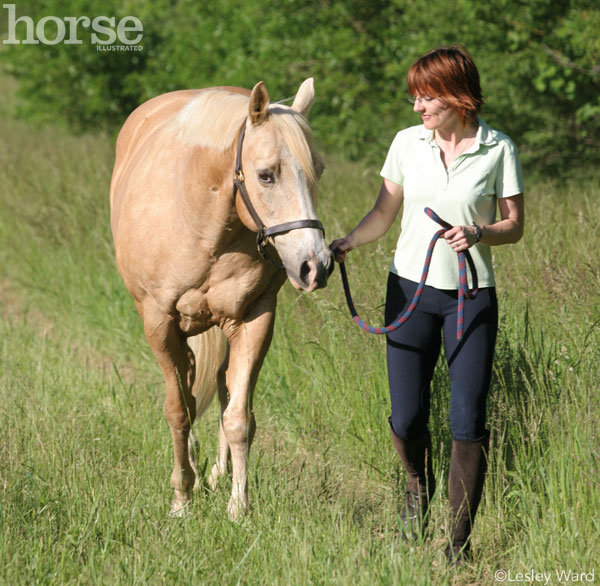Q: My horse is not respectful on the lead rope. He barges into my personal space and sometimes tries to bolt off. How can I teach him to lead more safely?

If your horse crowds you or pulls away from you, he’s disrespecting your personal space. He might be looking for security, think that he is in charge, be distracted, or simply have no idea that he’s supposed to maintain a particular distance. Whatever the cause, he’s putting you at risk.
Assume that your horse doesn’t know what you want. Someone, perhaps a previous owner, failed to teach him. His behaviors come directly from that hole in his education.
To get an attentive, respectful horse that responds quickly and consistently, plan to invest considerable time and effort. You must take your own attention and awareness to a new level. Your job is to focus on your horse so that he can learn to focus on you. Try the following exercise to teach your horse boundaries.
“Pay Attention” Exercise
Use minimal equipment: a flat leather halter and a cotton rope. Keep your horse busy. Ask him to walk, stop, back, go forward, turn to the right, straighten, turn to the left, straighten, stop, go forward, stand quietly, walk, stop, back, and stand again. Vary the sequence, and praise every effort. Whenever his attention wanders, ask him to do something. If he is beginning to do something on his own, ask him to do something else. If he’s looking off to his right, ask him to move ahead and turn left. If he’s slowing down, ask him for more energy. If he’s pushing forward too quickly, ask him to stop and stand.
Begin in a quiet environment without distractions. When your horse has become more reliably attentive, repeat those lessons in other locations and with distractions (such as an open field or an arena with other riders present). Eventually you’ll be able to keep his attention even in the face of multiple distractions.
You can help your horse teach himself to respect your space and maintain your preferred leading distance. For example, if he is coming too close on a turn, quietly bring your elbow up and out, toward him. As his shoulder encounters your elbow, he’ll feel a hard prod. If this seems to “just happen,” your horse will view it as a consequence of his own action.
Based on your description (“sometimes tries to”), your horse isn’t bolting. A bolting horse typically reacts with extreme fear by running away at speed; the handler’s only options are to (a) drop the rope, or (b) get dragged.
Your horse may pull on his lead rope simply because “over there” looks interesting. This inattention followed by action is preventable. Your horse’s posture will show changes whenever his attention shifts elsewhere. Before pulling away, he will stiffen slightly and raise his head to look in his chosen direction. If you see any hint of this, reclaim his attention—ask him to do something specific. It’s a friendly reminder that you’re in charge; it also makes “right here” a more interesting place.
Always ask nicely; this is training, not punishment. A request followed by a proper reward teaches your horse; a correction after the fact does not. Your positive attitude will be reflected in your horse’s positive attitude.
Liked this article? Here are others on behavior and training:
The Laws of the Lead Rope
The Spoiled Horse
JESSICA JAHIEL, PH.D., is the author of many popular books for equestrians, including The Horse Training Problem Solver, The Rider’s Problem Solver and The Horse Behavior Problem Solver. www.jessicajahiel.com
This article originally appeared in the June 2014 issue of Horse Illustrated magazine. Click here to subscribe!






Lots of good advise in this article.
What do you suggest for a horse that could care less about you? This horse will walk on the lead if he wants to. But also he will jerk out of nowhere and bolt, forcing you to let go of the lead rope. Or you get rope rash, at the very least. Right now we use a chain on him which works, but I don’t want to use it all the time.
Amanda. If my horse was acting up like that I would quick jerks on the lead to get his attention. Then we stop and stand. If he moves upu bring him bsck to thst starting point. He may jerk away but quick consistent reminders that you are in charge will remind him. It takes time consistency and patience. Just keep at it. He bolts awsy because he knows he can with you
Great tips. Taking horses on walks with you helps a lot too. I take my horses hiking with me and on walks with the dogs. They love it!